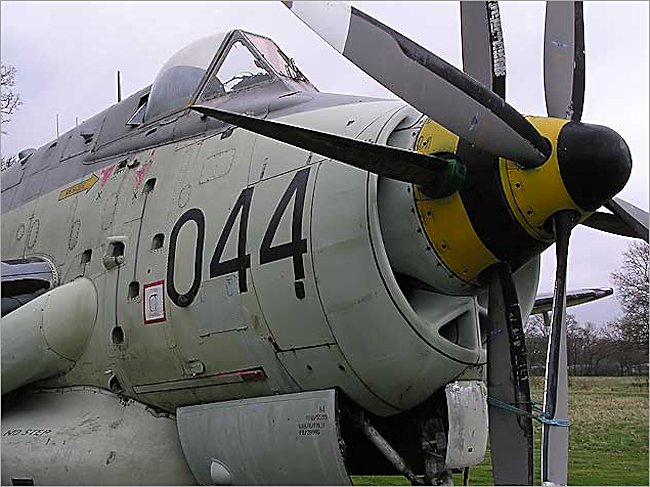Fairey Gannet AEW3
Gatwick Aviation Museum's Fairey Gannet A.E.W.3 XL472 served with 849 squadron 'A' flight on HMS Ark Royal and coded 421/R. On the 'Arks' last commission she was with 'B' flight and coded 044/R. Following disbandment of 849 squadron XL472 was used for instructional purposes Boscombe Down. XL472 was put up for sale by tender by the M.O.D. XL472 was purchased by Peter Vallance on the 18th of January 1991, arriving at Gatwick Aviation Museum in August 1991. It is still in the colours and markings of 849 squadron.
Fairey Gannet Carrier Bourne Anti-submarine Airborne Early Warning A.E.W. 3 The strange looking Fairey Gannet was originally designed as an anti-submarine aircraft. It has been called the ugliest aircraft in the world but it was an unsung hero. It was vital to the Royal Navy's anti-submarine defence for several years before helicopters took over this role. It was a mid-wing monoplane with a tricycle undercarriage and a crew of three, and double turboprop engine driving two contra-rotating propellers. The first flight of the Gannet was on the 19th of September 1949. It entered service with Royal Navy Fleet Air Arm flight 703X in April 1953. The Gannet was the first aircraft to use a double Mamba turbine engine in a single engine configuration, each unit powering a set of contra-rotating propellers. It was also the first turbo-propeller aircraft to land on an aircraft carrier. This event occurred on the 19th of June 1950 when a Gannet landed on the carrier HMS Illustrious.

Photograph taken at the Gatwick Aircraft Museum next to Gatwick Airport Sussex England
The Fairey Gannet had a maximum speed of 250 mph (217 kn, 402 km/h) with a range of 700 mi (609 nmi, 1127 km). It had a relatively low service ceiling of 25,000 ft (7,600 m). It had an endurance of 5-6 hours flying time. The Gannets entry into service was delayed because of some major teething problems with both the airframe and the systems integration. In March 1956 an up rated double Mamba engine was test flown and later fitted to all service aircraft. With the development of the dipping sonar in the US, the Fleet Air Arm need for a fixed wing ASW aircraft was in doubt. The Gannet in its ASW role was discontinued and the Gannet AS4 was paid off in July 1960.
Earlier trials had shown the effectiveness of airborne early warning aircraft. As a consequence the Gannet was modified to carry the APS 20F radar used in the trials. In this form, the Gannet AEW 3 first flew in August 1958 and entered service in March 1960. The pilot is seated well forward, conferring a good view over the nose for carrier operations. and sits over the Double Mamba engine, directly behind the gearbox and propellers. The second crew member, an aerial observer, is seated under a separate canopy directly behind the pilot. After the prototype, a second observer was included, in his own cockpit over the wing trailing edge

Photograph taken at the Gatwick Aircraft Museum next to Gatwick Airport Sussex England
In this role it carried an array of weapons in the internal bomb bay as well as a variety of external stores. A retractable radome housed a Ferranti ASV radar used for the detection of ships and surfaced submarines. The Gannet AEW 3 has power assisted folding wings to allow better storage on aircraft carriers. The Gannet's wing folds in two places to form a distinctive Z-shape on each side not just the normal one fold. By mid 1960 the anti-submarine-tasked Gannets were all replaced by the Westland Whirlwind in RN service. Airborne Early Warning Fairey Gannets were still deployed on carriers until December 1978 when the last unit, 849 squadron was disbanded
With a new Labour Government coming to power with a manifesto to cut the defence budget plans to keep the Fairey Gannet in operation for much longer than initially intended were put into place and the AEW.3s and a small number of COD.4s remained in service until more defence cuts from another government spelt the end of the RN's carrier force. The Gannets were flown to Lossiemouth, most to be scrapped. The radars were rescued and used by the RAF's Shackleton force for land-based AEW (bear in mind these same radars had been fitted to Skyraiders way back in the 1950s!) but the RN was now without any form of airborne early warning.
This stupid decision came back to bite the British Government in the summer of 1982. Less than 4 years after the retirement of the last AEW Fairey Gannet, several Royal Navy ships were lost to low level Argentine attacks during the Falklands War. Airborne early warning coverage would almost certainly have saved these ships and the sailors who lost their lives because of short-sighted defence cuts.
Only after the Falklands War did the Royal Navy get back some airborne early warning capability in the shape of hastily converted Sea King helicopters equipped with basic radar sets (similar to the sets used in RAF Nimrods, and not entirely suitable for the task). It took until 2002 for more modern and effective radars to be installed on these Sea Kings - so a full 24 years had passed before the Royal Navy got back AEW cover that was as effective as that provided by the Gannet. The retirement of HMS Ark Royal and its Harrier jump jets in Dec 2010 is another very stupid decision made by the British Government under the heading of defence cuts.
UPDATE;- I was sad to hear that the Gatwick Aircraft Museum's Fairey Gannet XL472 was sold and left the Museum 30th August 2013. It has gone to St Athan in South Wales
For News and information on visiting the Gatwick Aviation Museum go to their website at www.gatwick-aviation-museum.co.uk